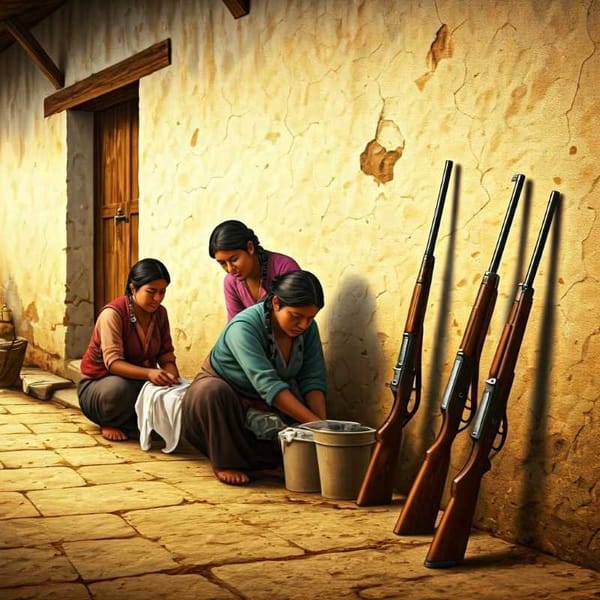Gangs, Grit, and Growing Up in the 1940s Mexico City
In the 1940s Mexico City, poverty and inequality birthed youth gangs. These weren't hardened criminals, but teens finding belonging and escape amidst urban sprawl. Their stories, etched in graffiti and court records, urge us to see them as victims of a city growing too fast, leaving them behind.

A social phenomenon that has historically occurred in the world's large cities is gangsterism. This has been identified as the formation of gangs made up, often, of adolescents searching for a collective identity. However, multiple problems can arise within gangs, such as violence and participation in criminal activities.
In the particular case of Mexico, the issue of violent gangs began in the 1940s. It is recorded that during this period there was an increase in the number of cases of young people arrested for the crime of criminal association, which implied that this sector was involved in groups that committed illicit activities, such as robbery, fraud, murder and rape.
The increase in cases of youth involved in gang activities occurred in the context of the growth of the country's urban areas, derived from rural migration and the strengthening of the manufacturing industry. One of the urban centers where this growth occurred was Mexico City, with the proliferation of new popular neighborhoods and the consolidation of the so-called “decent neighborhoods”, which also implied an increase in the presence of young people.
However, this situation accentuated another problem within the large urban sprawl, related to economic and social inequality. Since the areas identified as slums remained excluded from the country's economic progress, they lacked basic services such as electricity, water and drainage, as well as hospitals, schools and decent housing. In addition to the above, irregular settlements were displaced to make way for modern housing projects, which implied an extension of the urban ring towards the area adjacent to the State of Mexico.
These changes of “violent urbanization” that began in the 1940s ended up affecting the most vulnerable sectors. Faced with this panorama of marginalization and exclusion, some young people joined small groups aimed at forging a collective identity to protect themselves, take refuge or mitigate those denied needs.
Several of these gangs or neighborhood groups came to form a new expression of youth culture that sought to adapt to the changing context of the big city. However, in some cases, marginality, exposure to precariousness, coupled with processes of racialization and segregation, were factors that framed the violent behavior of certain gang groups and ended up being features of youth communities.
This characteristic of some gang groups soon became a weapon used against youth through preventive and criminalizing discourses, accompanied by a rhetoric that profiled precarious and racialized youth as enemies of the social order, thus stigmatizing marginalization and poverty.
To learn about the elements or situations that made criminal activities possible for some gang members, we can explore some cases registered by the Consejo Tutelar para Menores Infractores del Distrito Federal, in charge of following up on minors involved in crimes, including criminal association.
An example of this situation is the story of Pedro García, a 15-year-old boy who in April 1945 was arrested when he was caught stealing four tires along with two other people. Pedro confessed that his friends had planned the theft and that he decided to join as an “aguador” (watchman), arguing that he had done it to get the rent money his mother needed.
The court's resolution was probation, recognizing that the minor had acted out of economic necessity for his household and because of the bad influences of his friends. Likewise, his punishment consisted of having to report every month to the Social Prevention Department and to attend school while he was not working.
Another example is the case of young Luis Vargas Arroyo, nicknamed Tarzá, arrested in November 1943 for the crime of fraud and criminal association. The life of this adolescent was much harder when he was orphaned at a very young age, passing into the care of his aunt. Luis' situation would change again because after an argument with his guardian, he left the place where he lived on the advice of his friends.
While he remained on the street, he was working as a bricklayer's laborer and bakery assistant, since he had stopped attending school. El Tarzá was arrested while committing an offense along with four other friends, when they tried to obtain merchandise from Casa Solex with counterfeit vouchers provided by an individual identified as Jesús Huitrón. Finally, it was not possible to prove the suspects' guilt, and they were acquitted of any crime.
The situation of the two adolescents makes visible part of the problems that could lead an adolescent to join a gang. Deprivation and lack of opportunities are thus understood as two factors that influenced the incursion of young people into criminal acts. Likewise, the family situation was also one of the circumstances that led young people to gang membership and their involvement in criminal activities, especially those who left home and school.
The records in the AGN's custody provide insight into the multiple causes that in the mid-1940s negatively impacted the healthy development of youth, and also allow us to reconsider the importance of collective environments that promote the development of individual identity, as essential factors when designing social programs aimed at providing greater opportunities for Mexican youth.
Source: Archivo General de la Nación. ‘Pandillas en México en la década de 1940’. gob.mx, http://www.gob.mx/agn/articulos/pandillas-en-mexico-en-la-decada-de-1940?idiom=es. Accessed 18 Jan. 2024.




